Assessment of the Energy Security of EU Countries in Light of the Expansion of Renewable Energy Sources
Abstract
1. Introduction
2. Materials and Methods
3. Results
4. Discussion
5. Conclusions
Author Contributions
Funding
Data Availability Statement
Acknowledgments
Conflicts of Interest
Appendix A
| Component | Variable | Designation |
|---|---|---|
| Resource provision | Electricity imports, terawatt-hour (TWh) | RP1 |
| Electricity production from renewable sources, TWh | RP2 | |
| Electricity production from coal, TWh | RP3 | |
| Electricity production from fossil fuels, TWh | RP4 | |
| Electricity production from gas, TWh | RP5 | |
| Electricity production from low-carbon sources, TWh | RP6 | |
| Electricity production from oil, TWh | RP7 | |
| Electricity production from nuclear energy, TWh | RP8 | |
| Accessibility | The rural population’s access to electricity, % of the rural population | Ac1 |
| The urban population’s access to electricity, % of the urban population | Ac2 | |
| Consumption | Primary energy consumption per capita, kilowatt-hours/person | Con1 |
| Renewable energy consumption, % of the total final energy consumption | Con2 | |
| Primary energy consumption from biofuel per capita, TWh | Con3 | |
| Primary energy consumption from coal per capita, TWh | Con4 | |
| Demand for electricity, TWh | Con5 | |
| Primary energy consumption from gas per capita, TWh | Con6 | |
| Primary energy consumption from hydropower per capita, TWh | Con7 | |
| Primary energy consumption from low-carbon sources per capita, TWh | Con8 | |
| Primary energy consumption from nuclear power plants per capita, TWh | Con9 | |
| Primary energy consumption from oil per capita, TWh | Con10 | |
| Primary energy consumption from other renewable sources per capita, TWh | Con11 | |
| Primary energy consumption from solar energy per capita, TWh | Con12 | |
| Primary energy consumption from wind energy per capita, TWh | Con13 | |
| Compensatory measures | Rent for natural gas, % of GDP | Comp1 |
| Rent for coal, % of GDP | Comp2 | |
| Rent for oil, % of GDP | Comp3 | |
| Efficiency | Carbon intensity of electricity, greenhouse gas emissions per unit of energy used | Ef1 |
| The energy intensity level of primary energy, megajoules per unit of GDP at purchasing power parity in 2017 | Ef2 | |
| Safety | CO2 emissions, metric tons per capita | Saf1 |
| Greenhouse gas emissions, metric tons per capita | Saf2 | |
| The country’s contribution to the increase in the global average surface temperature due to the combined emissions of carbon dioxide, methane, and nitrogen oxide, % | Saf3 | |
| Innovativeness | The total number of patents in the field of energy consumption, unit | I1 |
| Patents in the field of carbon capture and storage, unit | I2 | |
| Patents in the field of solar photovoltaic systems, unit | I3 | |
| Patents in the field of thermal systems, unit | I4 | |
| Patents in the field of solar photovoltaic hybrid systems, unit | I5 | |
| Patents in the field of wind energy, unit | I6 | |
| Patents in the field of hydropower, unit | I7 | |
| Patents for the development of ocean power plants, unit | I8 | |
| Patents in the field of bioenergy, unit | I9 | |
| Patents for the construction of geothermal power plants, unit | I10 | |
| Patents for the manufacture of batteries, unit | I11 | |
| Patents for energy storage technologies, unit | I12 | |
| Patents in the field of accumulation of thermal energy, unit | I13 |
Appendix B
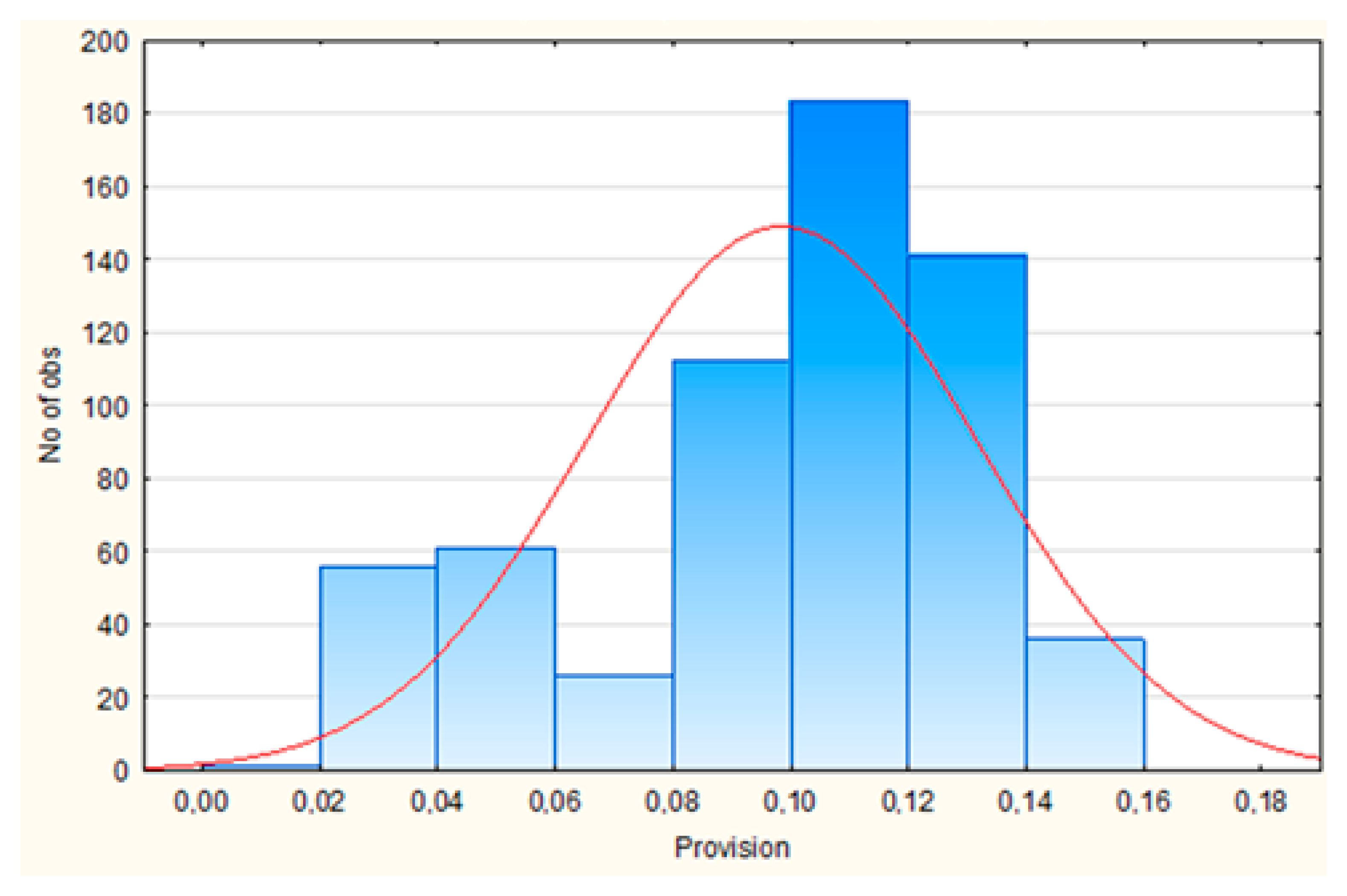

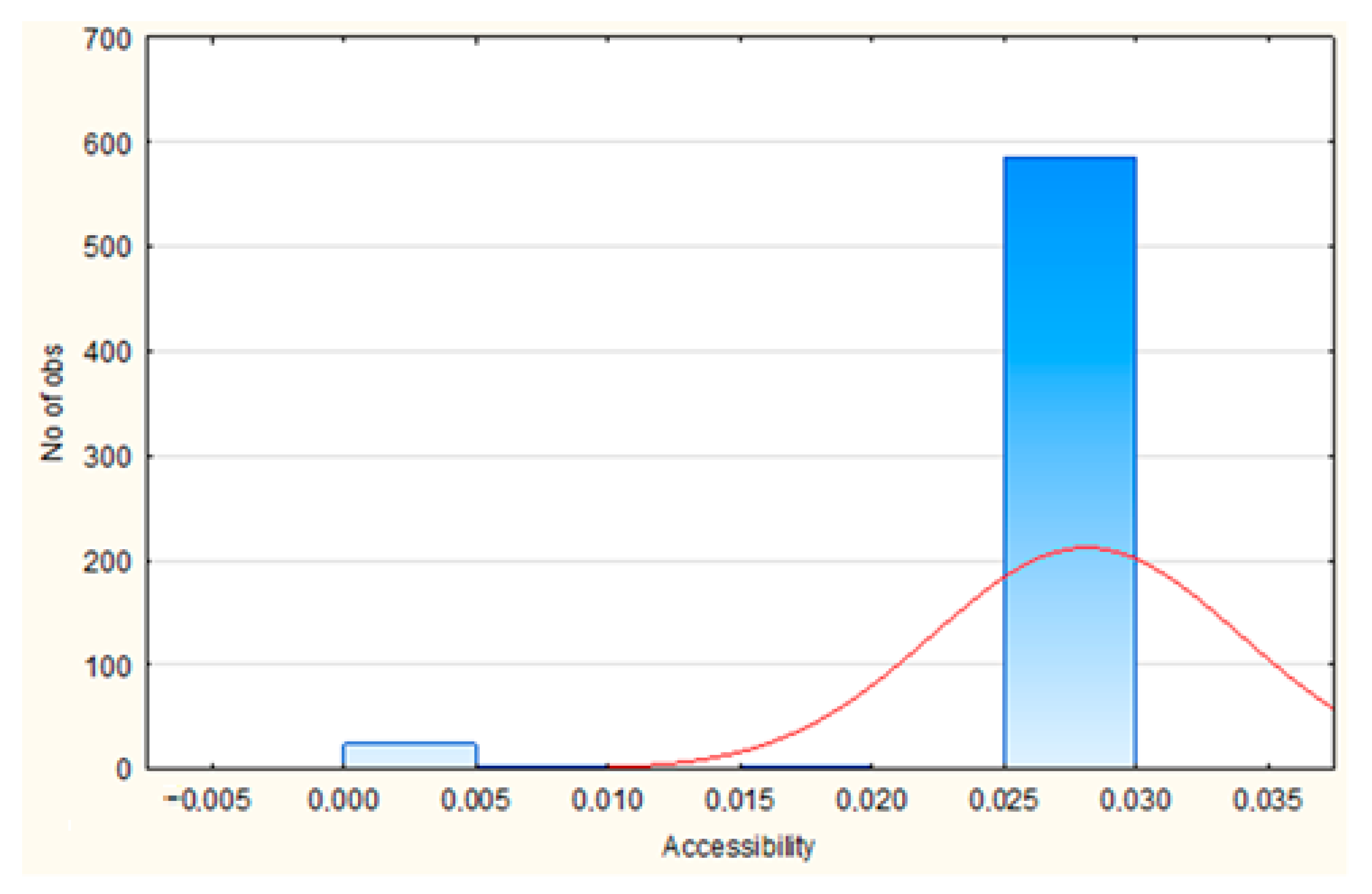


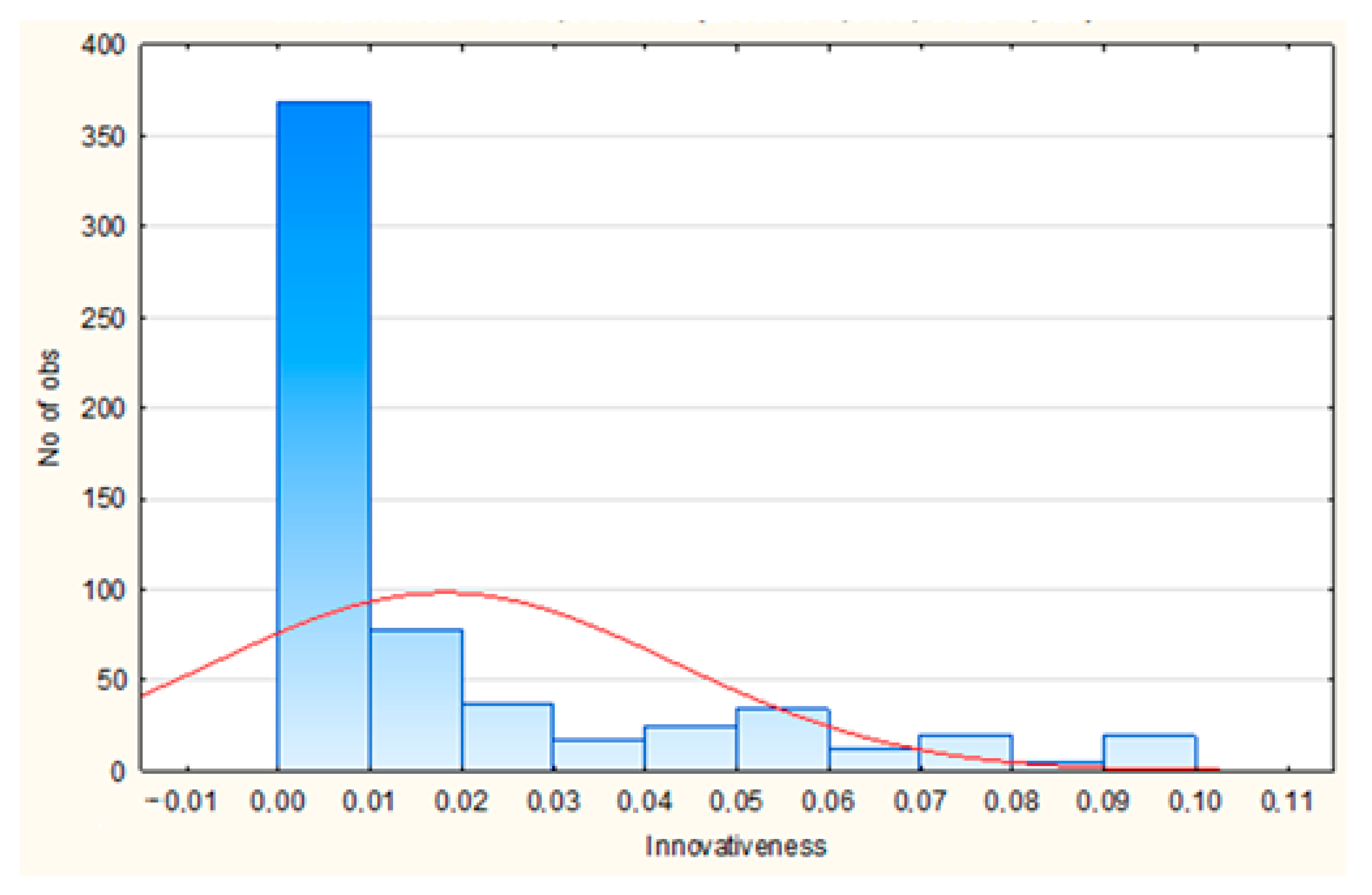
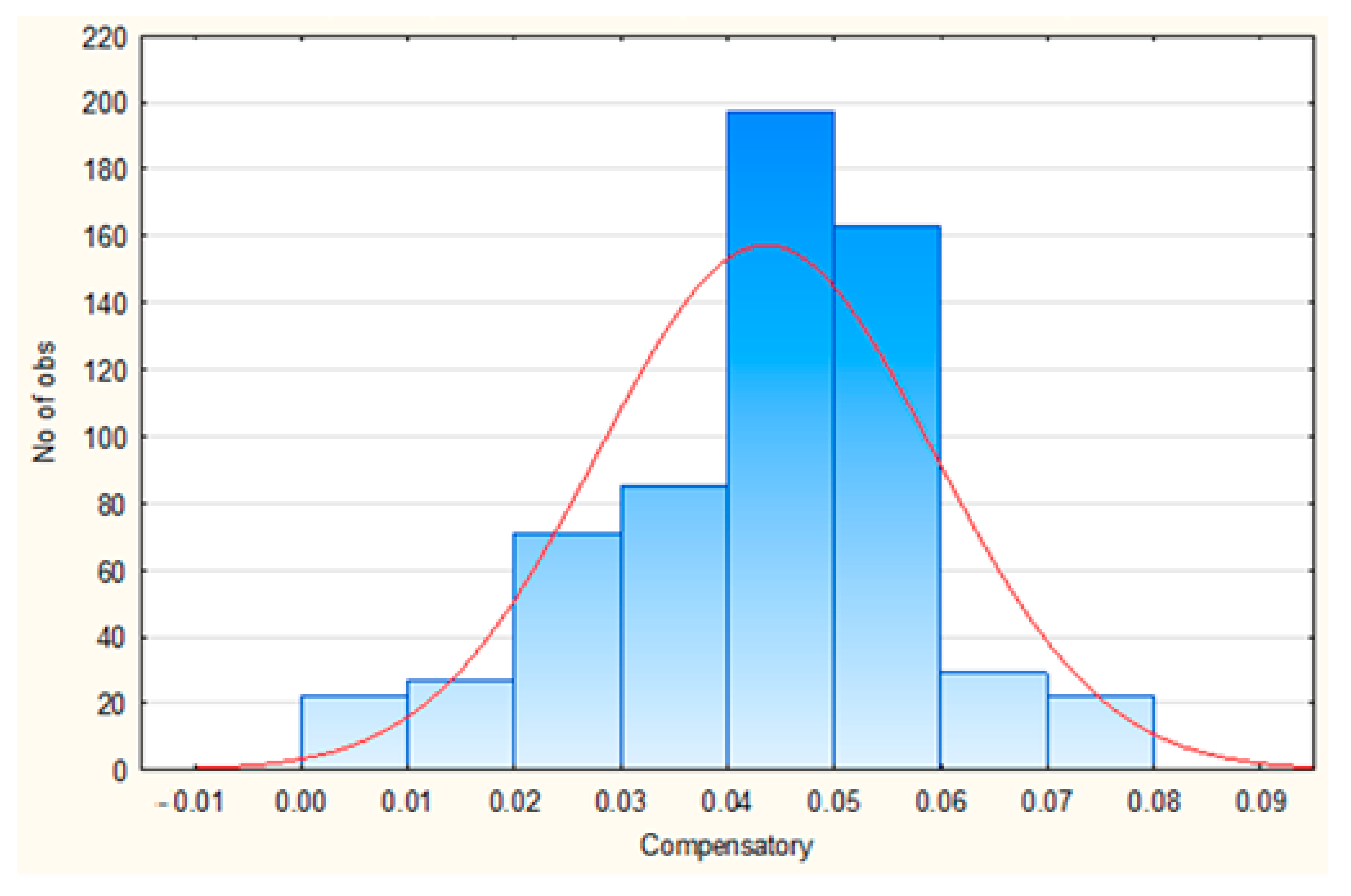
References
- European Commission. Available online: https://energy.ec.europa.eu/topics/energy-security/eu-energy-platform_en (accessed on 2 June 2024).
- The Intergovernmental Panel on Climate Change (IPCC). Available online: https://www.ipcc.ch/report/sixth-assessment-report-cycle/ (accessed on 2 June 2024).
- Kohlscheen, E.; Moessner, R.; Takats, E. Effects of Carbon Pricing and Other Climate Policies on CO2 Emissions; CESifo Working Paper No. 9347; CESifo: Munich, Germany, 2021. [Google Scholar] [CrossRef]
- Nationally Determined Contributions Under the Paris Agreement. In Proceedings of the Conference of the Parties Serving as the Meeting of the Parties to the Paris Agreement, Third Session, Glasgow, UK, 31 October–12 November 2023; Synthesis Report by the Secretariat, Advance Version. Available online: https://unfccc.int/documents/632334 (accessed on 2 June 2024).
- International Energy Agency Special Report “Net Zero by 2050. A Roadmap for the Global Energy Sector”. Available online: https://www.iea.org/reports/net-zero-by-2050 (accessed on 2 June 2024).
- The Global Risks Report 2023, 18th ed.; World Economic Forum: Geneva, Switzerland, 2023; Available online: https://www.weforum.org/reports/global-risks-report-2023 (accessed on 2 June 2024).
- Hübner, K. National Pathways to Low Carbon Emission Economies: Innovation Policies for Decarbonizing and Unlocking; Routledge: London, UK, 2019; Available online: https://www.routledge.com/National-Pathways-to-Low-Carbon-Emission-Economies-Innovation-Policies/Hubner/p/book/9780367587345 (accessed on 2 June 2024).
- Council of the EU and the European Council. Fit for 55—the EU’s Plan for a Green Transition—Consilium. Available online: https://www.consilium.europa.eu/en/policies/green-deal/fit-for-55/ (accessed on 2 June 2024).
- Wang, W.; Melnyk, L.; Kubatko, O.; Kovalov, B.; Hens, L. Economic and Technological Efficiency of Renewable Energy Technologies Implementation. Sustainability 2023, 15, 8802. [Google Scholar] [CrossRef]
- Bogdanov, D.; Ram, M.; Aghahosseini, A.; Traber, T.; Breyer, C. Low-cost renewable electricity as the key driver of the global energy transition towards sustainability. Energy 2021, 227, 120467. [Google Scholar] [CrossRef]
- Rosenbloom, D. Pathways: An emerging concept for the theory and governance of low-carbon transitions. Glob. Environ. Change 2017, 43, 37–50. [Google Scholar] [CrossRef]
- Man, O.R.; Radu, R.I.; Mihai, I.O.; Enache, C.M.; David, S.; Moisescu, F.; Ibinceanu, M.C.O.; Zlati, M.L. Approaches to a New Regional Energy Security Model in the Perspective of the European Transition to Green Energy. Economies 2024, 12, 61. [Google Scholar] [CrossRef]
- Kuzior, A. Development of offshore wind energy in Poland. AIP Conf. Proc. 2024, 3033, 020021. [Google Scholar] [CrossRef]
- Yu, B.; Fang, D.; Xiao, K.; Pan, Y. Drivers of renewable energy penetration and its role in power sector’s deep decarbonization towards carbon peak. Renew. Sustain. Energy Rev. 2023, 178, 113247. [Google Scholar] [CrossRef]
- Ouedraogo, N.S. Opportunities, Barriers and Issues with Renewable Energy Development in Africa: A Comprehensible Review. Curr. Sustain. Renew. Energy Rep. 2019, 6, 52–60. [Google Scholar] [CrossRef]
- Amir, M.; Khan, S.Z. Assessment of renewable energy: Status, challenges, COVID-19 impacts, opportunities, and sustainable energy solutions in Africa. Energy Built Environ. 2022, 3, 348–362. [Google Scholar] [CrossRef]
- Onopriienko, K.; Lovciová, K.; Mateášová, M.; Kuznyetsova, A.; Vasylieva, T. Economic policy to support lifelong learning system development & SDG4 achievement: Bibliometric analysis. Knowl. Perform. Manag. 2023, 7, 15–28. [Google Scholar] [CrossRef]
- Gajdzik, B.; Wolniak, R.; Nagaj, R.; Grebski, W.W.; Romanyshyn, T. Barriers to Renewable Energy Source (RES) Installations as Determinants of Energy Consumption in EU Countries. Energies 2023, 16, 7364. [Google Scholar] [CrossRef]
- Kuzior, A.; Vakulenko, I.; Kolosok, S.; Saher, L.; Lyeonov, S. Managing the EU energy crisis and greenhouse gas emissions: Seasonal ARIMA forecast. Probl. Perspect. Manag. 2023, 21, 383–399. [Google Scholar] [CrossRef]
- Monyei, C.G.; Sovacool, B.K.; Brown, M.A.; Jenkins, K.E.H.; Viriri, S.; Li, Y. Justice, poverty, and electricity decarbonization. Electr. J. 2019, 32, 47–51. [Google Scholar] [CrossRef]
- Sen, S.; Ganguly, S. Opportunities, barriers and issues with renewable energy development—A discussion. Renew. Sustain. Energy Rev. 2017, 69, 1170–1181. [Google Scholar] [CrossRef]
- Olanipekun, B.; Adelakun, N. Assessment of Renewable Energy in Nigeria: Challenges and Benefits. Int. J. Eng. Trends Technol. 2020, 68, 64–67. [Google Scholar] [CrossRef]
- Boczar, P.; Błażejczyk-Majka, L. Economic Efficiency versus Energy Efficiency of Selected Crops in EU Farms. Resources 2024, 13, 123. [Google Scholar] [CrossRef]
- Myroshnychenko, I.; Podosynnikov, S.; Halynskyi, D.; Ushkalov, M.; Chuhai, O. Regulatory Barriers For Entrepreneurship and Start-Ups In Renewable Energy: Bibliometric Analysis. SocioEcon. Chall. 2024, 8, 181–210. [Google Scholar] [CrossRef]
- Wołowiec, T.; Kolosok, S.; Vasylieva, T.; Artyukhov, A.; Skowron, Ł.; Dluhopolskyi, O.; Sergiienko, L. Sustainable Governance, Energy Security, and Energy Losses of Europe in Turbulent Times. Energies 2022, 15, 8857. [Google Scholar] [CrossRef]
- Chang, T.; Gupta, R.; Inglesi-Lotz, R.; Simo-Kengne, B.; Smithers, D.; Trembling, A. Renewable energy and growth: Evidence from heterogeneous panel of G7 countries using Granger causality. Renew. Sustain. Energy Rev. 2015, 52, 1405–1412. [Google Scholar] [CrossRef]
- Paraschiv, L.S.; Paraschiv, S. Contribution of renewable energy (hydro, wind, solar and biomass) to decarbonization and transformation of the electricity generation sector for sustainable development. Energy Rep. 2023, 9, 535–544. [Google Scholar] [CrossRef]
- Gajdzik, B.; Nagaj, R.; Wolniak, R.; Bałaga, D.; Žuromskait, B.; Grebski, W.W. Renewable energy share in European industry: Analysis and extrapolation of trends in EU countries. Energies 2024, 17, 2476. [Google Scholar] [CrossRef]
- Kacperska, E.; Łukasiewicz, K.; Pietrzak, P. Use of renewable energy sources in the European Union and the Visegrad Group Countries-Results of cluster analysis. Energies 2021, 14, 5680. [Google Scholar] [CrossRef]
- Brodny, J.; Tutak, M.; Bindzár, P. Assessing the level of renewable energy development in the European Union Member States. A 10-year perspective. Energies 2021, 14, 3765. [Google Scholar] [CrossRef]
- Khatiwada, D.; Vasudevan, R.A.; Santos, B.H. Decarbonization of natural gas systems in the EU—Costs, barriers, and constraints of hydrogen production with a case study in Portugal. Renew. Sustain. Energy Rev. 2022, 168, 112775. [Google Scholar] [CrossRef]
- Kuzior, A.; Samusevych, Y.; Lyeonov, S.; Krawczyk, D.; Grytsyshen, D. Applying Energy Taxes to Promote a Clean, Sustainable and Secure Energy System: Finding the Preferable Approaches. Energies 2023, 16, 4203. [Google Scholar] [CrossRef]
- Qadir, S.; Al-Motairi, H.; Tahir, F.; Al-Fagih, L. Incentives and strategies for financing the renewable energy transition: A review. Energy Rep. 2021, 7, 3590–3606. [Google Scholar] [CrossRef]
- Yoshimori, M. Global Cooperation for Reducing Carbon Emissions: The Role of Carbon Taxes. Financ. Mark. Inst. Risks 2024, 8, 69–79. [Google Scholar] [CrossRef]
- Moroz, A.; Lyeonov, S. Stimulating Financial-Fiscal Instruments of Supporting Development of Renewable Energy Sources: Bibliometric Analysis. Financ. Mark. Inst. Risks 2024, 8, 179–203. [Google Scholar] [CrossRef]
- Dobrovolska, O.; Ortmanns, W.; Podosynnikov, S.; Halynskyi, D.; Miniailo, A. Start-Ups and Entrepreneurship in Renewable Energy: Investments and Risks. Financ. Mark. Inst. Risks 2024, 8, 213–240. [Google Scholar] [CrossRef]
- Adun, H.; Ishaku, H.P.; Jazayeri, M.; Dagbasi, M.; Olusola, B.; Okoye, T.; Dike, G.C. Decarbonization of EU energy sector: Techno-feasibility analysis of 100% renewables by 2050 in Cyprus. Clean Technol. Environ. Policy 2022, 24, 2801–2824. [Google Scholar] [CrossRef]
- Ayuketah, Y.; Edimu, M.; Mwikirize, C.; Nsanyuy, W.B.; Ngole, E.B. Policy Perspectives of the Renewable Energy Landscape in Cameroon: Status, Drivers, Challenges and Enabling Frameworks. Energies 2024, 17, 5810. [Google Scholar] [CrossRef]
- Fashina, A.; Mundu, M.; Akiyode, O.; Abdullah, L.; Sanni, D.; Ounyesiga, L. The Drivers and Barriers of Renewable Energy Applications and Development in Uganda: A Review. Clean Technol. 2018, 1, 9–39. [Google Scholar] [CrossRef]
- Sotnyk, I.; Kurbatova, T.; Trypolska, G.; Sokhan, I.; Koshel, V. Research trends on development of energy efficiency and renewable energy in households: A bibliometric analysis. Environ. Econ. 2023, 14, 13–27. [Google Scholar] [CrossRef]
- Sotnyk, I.; Kurbatova, T.; Kubatko, O.; Prokopenko, O.; Järvis, M. Managing energy efficiency and renewable energy in the residential sector: A bibliometric study. Probl. Perspect. Manag. 2023, 21, 511–527. [Google Scholar] [CrossRef]
- Vasilyeva, T.; Samusevych, Y.; Babenko, V.; Bestuzheva, S.; Bondarenko, S.; Nesterenko, I. Environmental Taxation: Role in Promotion of the Pro-Environmental Behaviour. WSEAS Trans. Bus. Econ. 2023, 20, 410–427. [Google Scholar] [CrossRef]
- Wang, F.; Jia, Y.; Li, G.; Lam, M.; Liu, Y. An Empirical Study of the Relationship Between Digital Transformation, Corporate Social Responsibility and Financial Performance. Bus. Ethics Leadersh. 2024, 8, 57–73. [Google Scholar] [CrossRef]
- Vakulenko, I.; Saher, L.; Shymoshenko, A. Systematic literature review of carbon-neutral economy concept. SocioEcon. Chall. 2023, 7, 139–148. [Google Scholar] [CrossRef]
- Chygryn, O.; Bektas, C.; Havrylenko, O. Innovation and Management of Smart Transformation Global Energy Sector: Systematic Literature Review. Bus. Ethics Leadersh. 2023, 7, 105–112. [Google Scholar] [CrossRef]
- Badreddine, A.; Larbi Cherif, H. Public health improvement by reducing air pollution: A strategy for the transition to renewable energy. Health Econ. Manag. Rev. 2024, 5, 1–14. [Google Scholar] [CrossRef]
- Firstová, J.; Vysochyna, A. Optimisation of socio-economic, environmental and public health determinants of national security for post-pandemic recovery. Health Econ. Manag. Rev. 2024, 5, 67–79. [Google Scholar] [CrossRef]
- Matvieieva, Y.; Sulym, V.; Rosokhata, A.; Jasnikowski, A. Influence of Waste Incineration and Obtaining Energy from it to the Public Health for Certain Territories: A Bibliometric and Substantive Study. Health Econ. Manag. Rev. 2023, 4, 71–80. [Google Scholar] [CrossRef]
- Liwång, H. Future National Energy Systems, Energy Security and Comprehensive National Defence. Energies 2023, 16, 6627. [Google Scholar] [CrossRef]
- Jiang, Y.; Liu, X. A Bibliometric Analysis and Disruptive Innovation Evaluation for the Field of Energy Security. Sustainability 2023, 15, 969. [Google Scholar] [CrossRef]
- Balcerzak, A.P.; Uddin, G.S.; Igliński, B.; Pietrzak, M.B. Global energy transition: From the main determinants to economic challenges. Equilib. Q. J. Econ. Econ. Policy 2023, 18, 597–608. [Google Scholar] [CrossRef]
- Samusevych, Y.; Vysochyna, A.; Vasylieva, T.; Lyeonov, S.; Pokhylko, S. Environmental, energy and economic security: Assessment and interaction. E3S Web Conf. 2021, 234, 00012. [Google Scholar] [CrossRef]
- Smal, T.; Wieprow, J. Energy Security in the Context of Global Energy Crisis: Economic and Financial Conditions. Energies 2023, 16, 1605. [Google Scholar] [CrossRef]
- Mauro, M.R. Energy Security, Energy Transition, and Foreign Investments: An Evolving Complex Relationship. Laws 2024, 13, 48. [Google Scholar] [CrossRef]
- Zając, A.; Balina, R.; Kowalski, D. Financial and Economic Stability of Energy Sector Enterprises as a Condition for Poland’s Energy Security—Legal and Economic Aspects. Energies 2023, 16, 1442. [Google Scholar] [CrossRef]
- Konopelko, A.; Kostecka-Tomaszewska, L.; Czerewacz-Filipowicz, K. Rethinking EU Countries’ Energy Security Policy Resulting from the Ongoing Energy Crisis: Polish and German Standpoints. Energies 2023, 16, 5132. [Google Scholar] [CrossRef]
- Joostberens, J.; Rybak, A.; Rybak, A. The Use of Fuzzy Modelling Based on Expert Knowledge to Determine Poland’s Energy Security Index Taking into Account Political Conditions. Appl. Syst. Innov. 2024, 7, 82. [Google Scholar] [CrossRef]
- Starzyńska, D.; Kuna-Marszałek, A. Development of Renewable Energy in View of Energy Security—The Study of the Photovoltaic Market in Poland. Energies 2023, 16, 6992. [Google Scholar] [CrossRef]
- Kramens, J.; Svedovs, O.; Sturmane, A.; Vigants, E.; Kirsanovs, V.; Blumberga, D. Exploring Energy Security and Independence for Small Energy Users: A Latvian Case Study on Unleashing Stirling Engine Potential. Sustainability 2024, 16, 1224. [Google Scholar] [CrossRef]
- Ziabina, Y.; Iskakov, A.; Senyah, M.M. Waste management system: Key determinants of green development and energy balance transformation. SocioEcon. Chall. 2023, 7, 161–172. [Google Scholar] [CrossRef]
- Curtis, A.; McLellan, B. Energy Security Blind Spots of Gas, Oil, and Coal Exporters. Methane 2024, 3, 191–213. [Google Scholar] [CrossRef]
- Vivoda, V. Australia’s Energy Security and Statecraft in an Era of Strategic Competition. Energies 2022, 15, 6935. [Google Scholar] [CrossRef]
- Mentel, G.; Vasilyeva, T.; Samusevych, Y.; Vysochyna, A.; Karbach, R.; Streimikis, J. The evaluation of economic, environmental and energy security: Composite approach. Int. J. Glob. Environ. Issues 2020, 19, 177. [Google Scholar] [CrossRef]
- Bilan, Y.; Samusevych, Y.; Lyeonov, S.; Strzelec, M.; Tenytska, I. The Keys to Clean Energy Technology: Impact of Environmental Taxes on Biofuel Production and Consumption. Energies 2022, 15, 9470. [Google Scholar] [CrossRef]
- Lyeonov, S.; Vysochyna, A.; Śmiech, L.; Rabe, M. Economic growth and national security: Patterns of European countries’ resistance to global turbulences. J. Int. Stud. 2024, 17, 182–204. [Google Scholar] [CrossRef]
- Abdullah, F.B.; Iqbal, R.; Ahmad, S.; El-Affendi, M.A.; Abdullah, M. An Empirical Analysis of Sustainable Energy Security for Energy Policy Recommendations. Sustainability 2022, 14, 6099. [Google Scholar] [CrossRef]
- Yu, H.; Yuan, G.; Kong, D.; Lei, L.; He, Y. An Optimised Method for Nonlinear Function Approximation Based on Multiplierless Piecewise Linear Approximation. Appl. Sci. 2022, 12, 10616. [Google Scholar] [CrossRef]
- Pele, O.; Taskar, B.; Globerson, A.; Werman, M. The Pairwise Piecewise-Linear Embedding for Efficient Non-Linear Classification. In Proceedings of the 30th International Conference on Machine Learning, ICML 2013, Atlanta, GA, USA, 16–21 June 2013; pp. 205–213. Available online: https://www.semanticscholar.org/paper/The-Pairwise-Piecewise-Linear-Embedding-for-Pele-Taskar/182fe4e43c203dda8d3d17107ba2b09042210227 (accessed on 2 June 2024).
- Rangel de Castro Soares, B.; Almeida, K.C. Piecewise Linear Approximations of the Hydro Power Producer Problem. In Proceedings of the XXII Congresso Brasileiro de Automática, João Pessoa, Brazil, 9–12 September 2018; Available online: https://www.researchgate.net/publication/329619388_Piecewise_Linear_Approximations_of_the_Hydro_Power_Producer_Problem (accessed on 2 June 2024).
- Quevedo, J.R.; Bahamonde, A.; Luaces, O. A simple and efficient method for variable ranking according to their usefulness for learning. Comput. Stat. Data Anal. 2007, 52, 578–595. [Google Scholar] [CrossRef][Green Version]
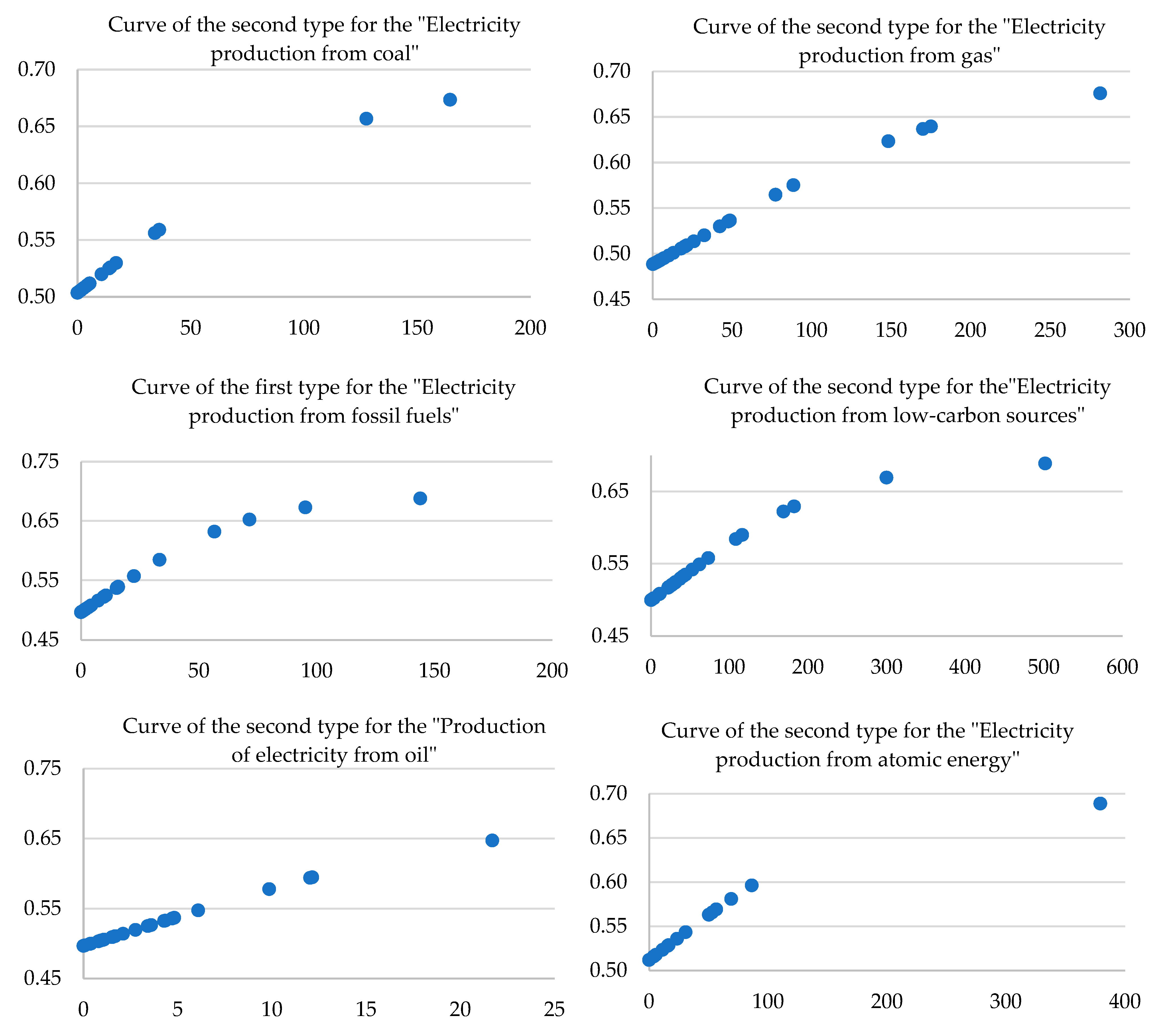

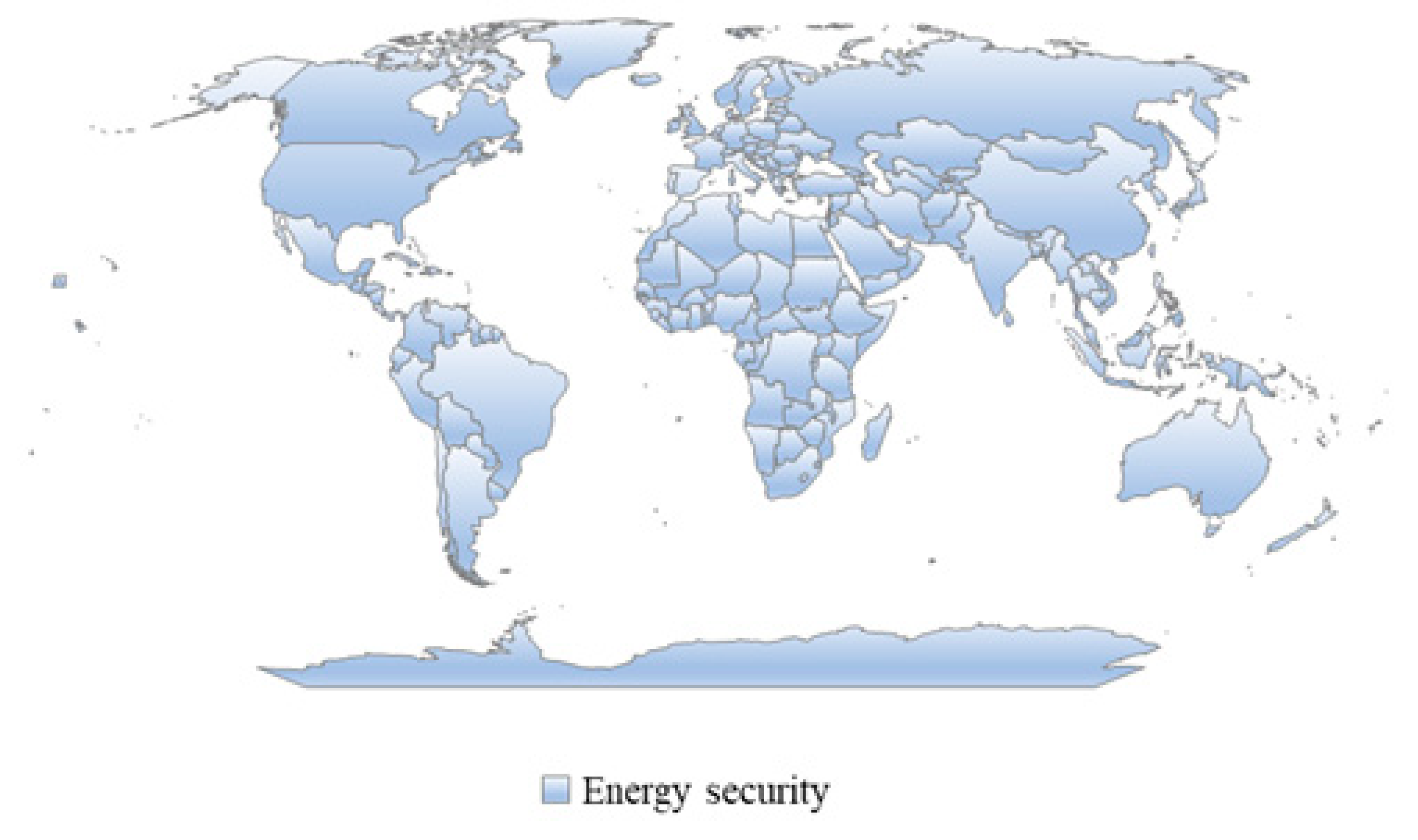
| Value | Level | Characteristic |
|---|---|---|
| 0.8–1.0 | High | The condition of the country’s energy system ensures the continuous, cost-effective, reliable, technically advanced, environmentally safe, and economically sustainable fulfilment of consumers’ present and future energy demands in quantities adequate to support economic growth and defense requirements. The country is capable of producing sufficient energy resources not only for domestic use but also for export. |
| 0.6–0.8 | Sufficient | Countries with an ample supply of domestic energy resources and the imperative to reform their energy markets to enhance the management efficiency of energy development components and boost the proportion of renewable energy sources. |
| 0.4–0.6 | Moderate | Countries with a moderate energy security level, attributed to inadequate domestic energy resources, limited capacity in their energy markets to adopt new energy-efficient and energy-saving technologies, modern control, management, and accounting systems for energy consumption, and establishing a competitive environment to ensure sustainable economic development. |
| 0.2–0.4 | Low | Countries lacking adequate energy resources experience high levels of energy dependence, an unbalanced and economically unjustified pricing policy for energy products, low readiness and innovation among energy market participants in adopting new energy-efficient and energy-saving technologies, and an energy sector that struggles to adapt to consumer needs and global market changes. |
| 0–0.2 | Critical | Countries facing a substantial deficit in energy resources find their energy systems vulnerable to external and internal threats. The volume of human-caused greenhouse gas emissions far surpasses the capacity of measures to reduce CO2 emissions and environmental clean-up efforts, exacerbated by the scarcity of energy resources, a minimal proportion of renewable energy sources, and an ineffective management framework for the country’s energy development. |
| Variable | Minimum Value | Maximum Value | Average Value | Standard Deviation |
|---|---|---|---|---|
| RP1 | −77.03 | 50.97 | −0.07 | 16.02 |
| RP2 | 0.00 | 251.48 | 24.10 | 37.61 |
| RP3 | 0.00 | 304.63 | 27.08 | 53.75 |
| RP4 | 0.24 | 402.40 | 57.53 | 82.79 |
| RP5 | 0.00 | 172.77 | 18.09 | 30.67 |
| RP6 | 0.00 | 530.51 | 57.36 | 103.61 |
| RP7 | 0.00 | 93.59 | 5.83 | 9.91 |
| RP8 | 0.00 | 451.53 | 32.71 | 81.19 |
| Ac1 | 77.76 | 100.00 | 99.44 | 2.67 |
| Ac2 | 92.76 | 100.00 | 99.75 | 0.94 |
| Con1 | 15,779.98 | 113,106.20 | 42,330.54 | 17,458.33 |
| Con2 | 0.00 | 58.40 | 16.55 | 11.70 |
| Con3 | 0.00 | 1747.47 | 126.54 | 249.54 |
| Con4 | 0.00 | 38,178.08 | 6514.54 | 6676.22 |
| Con5 | 1.92 | 2976.69 | 203.21 | 523.05 |
| Con6 | 0.00 | 30,380.21 | 8121.56 | 5550.22 |
| Con7 | 0.00 | 26,194.45 | 2597.67 | 4271.66 |
| Con8 | 0.00 | 50,470.69 | 8621.49 | 9152.53 |
| Con9 | 0.00 | 23,852.87 | 3920.23 | 5287.17 |
| Con10 | 0.00 | 80,359.70 | 16,397.78 | 12,010.95 |
| Con11 | 0.00 | 7845.18 | 902.16 | 1352.85 |
| Con12 | 0.00 | 1709.75 | 186.06 | 318.03 |
| Con13 | 0.00 | 7361.92 | 891.37 | 1332.98 |
| Comp1 | 0.00 | 2.00 | 0.16 | 0.30 |
| Comp2 | 0.00 | 2.71 | 0.18 | 0.37 |
| Comp3 | 0.00 | 2.05 | 0.16 | 0.32 |
| Ef1 | 42.37 | 801.86 | 377.29 | 184.95 |
| Ef2 | 1.11 | 15.20 | 3.67 | 1.54 |
| Saf1 | 2.93 | 25.61 | 7.44 | 3.47 |
| Saf2 | −9.33 | 26.63 | 8.32 | 4.45 |
| Saf3 | 0.00 | 3.64 | 0.47 | 0.69 |
| I1 | 1.00 | 9966.00 | 447.92 | 1326.37 |
| I2 | 0.00 | 50.00 | 9.01 | 11.29 |
| I3 | 1.00 | 1227.00 | 49.93 | 138.70 |
| I4 | 0.00 | 940.00 | 34.22 | 93.38 |
| I5 | 0.00 | 129.00 | 6.87 | 16.26 |
| I6 | 0.00 | 726.00 | 52.74 | 116.69 |
| I7 | 0.00 | 144.00 | 8.23 | 15.63 |
| I8 | 0.00 | 77.00 | 5.46 | 10.38 |
| I9 | 0.00 | 451.00 | 27.90 | 55.51 |
| I10 | 0.00 | 90.00 | 3.14 | 8.68 |
| I11 | 0.00 | 1714.00 | 45.01 | 186.59 |
| I12 | 0.00 | 94.00 | 3.89 | 10.41 |
| I13 | 0.00 | 140.00 | 6.04 | 18.13 |
| Variable | Rank | Weighting Coefficient | Variable | Rank | Weighting Coefficient |
|---|---|---|---|---|---|
| RP1 | 29 | 0.016 | Con13 | 12 | 0.033 |
| RP2 | 25 | 0.020 | Comp1 | 20 | 0.025 |
| RP3 | 25 | 0.020 | Comp2 | 20 | 0.025 |
| RP4 | 25 | 0.020 | Comp3 | 20 | 0.025 |
| RP5 | 25 | 0.020 | Ef1 | 3.5 | 0.042 |
| RP6 | 25 | 0.020 | Ef2 | 3.5 | 0.042 |
| RP7 | 25 | 0.020 | Saf1 | 1.5 | 0.044 |
| RP8 | 25 | 0.020 | Saf2 | 1.5 | 0.044 |
| Ac1 | 30.5 | 0.015 | Saf3 | 5 | 0.040 |
| Ac2 | 30.5 | 0.015 | I1 | 38 | 0.007 |
| Con1 | 12 | 0.033 | I2 | 38 | 0.007 |
| Con2 | 12 | 0.033 | I3 | 38 | 0.007 |
| Con3 | 12 | 0.033 | I4 | 38 | 0.007 |
| Con4 | 12 | 0.033 | I5 | 38 | 0.007 |
| Con5 | 12 | 0.033 | I6 | 38 | 0.007 |
| Con6 | 12 | 0.033 | I7 | 38 | 0.007 |
| Con7 | 12 | 0.033 | I8 | 38 | 0.007 |
| Con8 | 12 | 0.033 | I9 | 38 | 0.007 |
| Con9 | 12 | 0.033 | I10 | 38 | 0.007 |
| Con10 | 12 | 0.033 | I11 | 38 | 0.007 |
| Con11 | 12 | 0.033 | I12 | 38 | 0.007 |
| Con12 | 12 | 0.033 | I13 | 38 | 0.007 |
| Value | Level | Countries |
|---|---|---|
| 0.6–0.8 | Sufficient | Slovak Republic, Estonia, Ireland, Slovenia, Spain, Belgium, Czech Republic, Austria, Poland, the Netherlands, Finland, France, Germany |
| 0.4–0.6 | Moderate | Cyprus, Croatia, Latvia, Portugal, Romania, Lithuania, Denmark, Luxembourg, Sweden, Hungary, Ukraine, Bulgaria, Italy, Greece |
| 0–0.2 | Critical | Malta |
Disclaimer/Publisher’s Note: The statements, opinions and data contained in all publications are solely those of the individual author(s) and contributor(s) and not of MDPI and/or the editor(s). MDPI and/or the editor(s) disclaim responsibility for any injury to people or property resulting from any ideas, methods, instructions or products referred to in the content. |
© 2025 by the authors. Licensee MDPI, Basel, Switzerland. This article is an open access article distributed under the terms and conditions of the Creative Commons Attribution (CC BY) license (https://creativecommons.org/licenses/by/4.0/).
Share and Cite
Kuzior, A.; Kovalenko, Y.; Tiutiunyk, I.; Hrytsenko, L. Assessment of the Energy Security of EU Countries in Light of the Expansion of Renewable Energy Sources. Energies 2025, 18, 2126. https://doi.org/10.3390/en18082126
Kuzior A, Kovalenko Y, Tiutiunyk I, Hrytsenko L. Assessment of the Energy Security of EU Countries in Light of the Expansion of Renewable Energy Sources. Energies. 2025; 18(8):2126. https://doi.org/10.3390/en18082126
Chicago/Turabian StyleKuzior, Aleksandra, Yevhen Kovalenko, Inna Tiutiunyk, and Larysa Hrytsenko. 2025. "Assessment of the Energy Security of EU Countries in Light of the Expansion of Renewable Energy Sources" Energies 18, no. 8: 2126. https://doi.org/10.3390/en18082126
APA StyleKuzior, A., Kovalenko, Y., Tiutiunyk, I., & Hrytsenko, L. (2025). Assessment of the Energy Security of EU Countries in Light of the Expansion of Renewable Energy Sources. Energies, 18(8), 2126. https://doi.org/10.3390/en18082126







